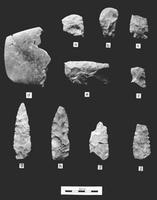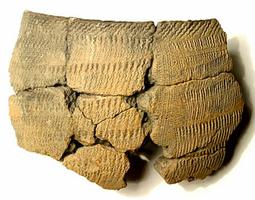Woodland Culture
The Woodland culture comprises various cultural manifestations that took place mainly in southern Ontario and Québec between 3000 and 500 years Before Present (BP). Archaeologists classify the Woodland period into three distinct episodes: Early Woodland (3000-2400 BP), Middle Woodland (2400-1000 BP) and Late Woodland (1000-500 BP). The emergence of pottery vessels, which is a remarkable technological evolution, represents the key element distinguishing sites from the Woodland period from those of the Archaic and Palaeoindian periods.
Early Woodland
The Early Woodland period (3000-2400 BP) is primarily associated with the occupation of the territory by cultural groups known as Meadowood. In general, the Woodland period marks the beginning of a true cultural regionalization and the establishment of a vast exchange network of goods, ideas and individuals, which did not exist during the Archaic period.
Three types of sites characterize the presence of Meadowood groups. First, there are burial sites that show the presence of complex behaviours including body cremation, which is often accompanied by multiple offerings of household tools, objects made specifically for the ritual and red ochre. There are also camps related to fall activities, or showing evidence of spring and summer fishing activities along the rivers. The third type corresponds to the most distinctive behaviour of this cultural group: the intensive exploitation of quarries located primarily in southeastern Ontario. The Meadowood toolbox included items manufactured mostly from Onondaga chert, including Meadowood-style points, cache blades and characteristic triangular scrapers, as well as unsophisticated cord-impressed fired-clay pottery called Vinette 1. Towards the end of this period, there were also remains associated with the mortuary practices of another cultural group called Middlesex, which is distinguished by the presence of bird-shaped stones and bifacial blades made of exotic chert obtained mainly from the Ohio Valley.
Middle Woodland
The Middle Woodland period (2400-1000 BP) is associated with the presence of various cultures named Couture, Saugeen, Point Peninsula, Princess Point and Laurel in southern and northwestern Ontario, and Point Peninsula and Melocheville tradition in southern and central Québec. However, scattered evidence showing the influence of Woodland groups was also found in New Brunswick (eg, at the Mud Lake Stream, Diggity, Oxbow and Augustine Mound sites), and even as far as Blackfoot Crossing, near Cluny, Alberta. There are very few cultural traits that distinguish the Early and Late Woodland periods, except for some changes in projectile point styles, the abundance of exotic chert, and the decoration of pottery, which is also found in greater quantities during the later period.
The Middle period is the least documented of all Woodland cultural episodes. It was characterized by a reorganization of trade and social networks and greater cultural regionalization. The abundance of remains found at some sites indicates that they were occupied for long periods, suggesting that the population was expanding or that large groups gathered at certain times of the year for the intensive exploitation of fishery resources. People also increasingly varied their subsistence activities and started to collect wild fruits. In Ontario, there is even evidence for the intensive exploitation of Wild Rice. In some areas, burial practices become more sophisticated, including at Serpent Mound and Rainy River Mounds in Ontario, where large burial mounds are found.
The Late Middle Woodland period was mostly characterized by the diversification of pottery-making techniques, including the emergence of the coil technique, the presence of platform pipes and the reoccupation of the territories by different cultural groups. This is also when the first horticultural experiments were carried out in Ontario, and Corn was progressively introduced into the diet.
Late Woodland
The Late Woodland period (1000-500 BP) is linked to the presence of diverse cultural manifestations known as the Owasco in Quebec and Pickering, Glen Meyer, Uren and Middleport in Ontario. These groups were the ancestors of the nations that inhabited these regions towards the end of the Woodland period: Huron and Petun in south-central Ontario, Erie and Neutral in southwest Ontario, and St Lawrence Iroquoian in southeastern Ontario and southern and central Quebec.
The first evidence of an embryonic sedentary village lifestyle is associated with the beginning of the Late Woodland Period. Remains of the first elliptical houses appeared in southwestern Ontario around 900-1000 AD as precursors of the Longhouses that were later found among historic Iroquoian groups (Huron, Neutral, Erie and St Lawrence Iroquoian). People continued to develop their knowledge of horticulture, which had already started in southwestern Ontario by 600 AD, and also gradually learned how to cultivate corn on a large scale. Towards the end of the 12th century, most cultivated plants including corn, bean, Squash and Sunflower were present in Ontario's village sites. It was not until the early 14th century, however, that the earliest evidence of corn appeared in a village in Québec, at the McDonald Site, whereas appreciable amounts of the other cultivated plants were first present at the late 15th-century Droulers Site.
By the middle of the Late Woodland Period, there was a significant increase in populations, which then resided permanently in villages consisting of several rectangular longhouses, sometimes surrounded by a fence comprising multiple rows. Villages were mostly built on hills located away from major rivers, usually near a small stream and often near a swamp. People practised a mixed horticulture and their diet still focused primarily on the use of cultivated plants, particularly corn. Fishing and hunting remained complementary activities that were necessary to ensure people's survival at certain times of the year.
During this period, ceramic vessels for cooking and storing food became increasingly sophisticated and clay was modelled using a paddle and probably an anvil. Many different patterns were used for decoration, ranging from simple parallel lines to complex geometric shapes. The use of tools made from mammal bones (deer, bear and beaver) became widespread while stone tools were considerably scarcer. The discovery of numerous pipe fragments on sites indicates that tobacco was frequently used.
Soon after, the arrival of the "iron men who came from beyond the great water," whose precursor is the famous Jacques Cartier, caused important changes in the lifestyle of these Canadian Prehistoric agricultural communities.

 Share on Facebook
Share on Facebook Share on X
Share on X Share by Email
Share by Email Share on Google Classroom
Share on Google Classroom














